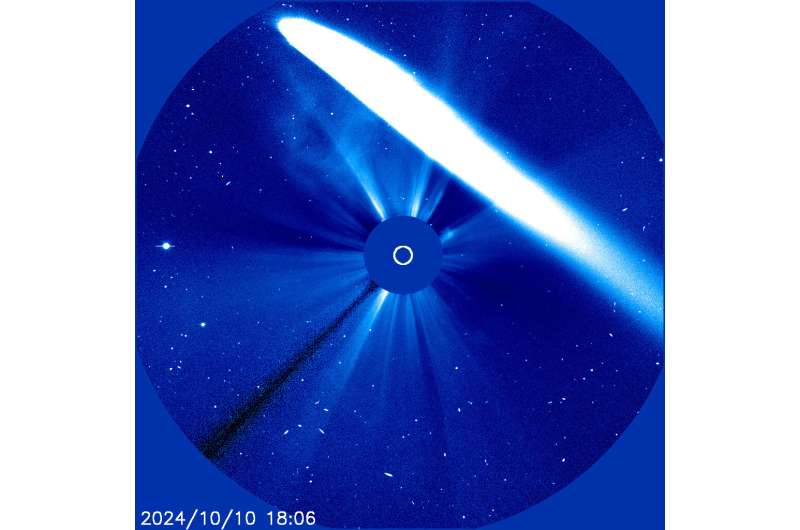The European Space Agency (ESA) and NASA‘s Solar and Heliospheric Observatory (SOHO) have captured stunning images of the second-brightest comet to ever grace SOHO’s field of view. Dubbed Comet C/2023 A3 Tsuchinshan-ATLAS, this celestial wonder has been captivating skywatchers around the world with its long, dusty tail. As the comet makes its debut in the evening sky, astronomers and the general public alike can help SOHO discover even more comets by participating in the Sungrazer Project.

SOHO Captures Comet C/2023 A3 Tsuchinshan-ATLAS in Stunning Detail
The Solar and Heliospheric Observatory (SOHO), a joint mission between ESA and NASA, has been a prolific comet hunter since its launch in 1995. Over the course of its nearly 29-year career, SOHO has captured images of numerous comets, including the brightest one to grace its field of view – Comet McNaught, observed in 2007.
Now, SOHO has set its sights on another celestial wonder – Comet C/2023 A3 Tsuchinshan-ATLAS. This comet has been making headlines in recent weeks, dazzling skywatchers with its long, dusty tail that has been visible in the pre-dawn sky throughout late September and early October. SOHO’s LASCO (Large Angle and Spectrometric Coronagraph Experiment) instrument, which uses a disk to block the sun’s bright light, has been instrumental in capturing the comet’s journey.
On October 10, 2024, SOHO snapped a stunning image of the comet and its tail streaming from the upper left to the right, with the planet Mercury appearing as a bright dot on the left. This image provides a unique perspective on the comet, as it passes through SOHO’s field of view, offering insights into its structure and behavior.
Comet C/2023 A3 Tsuchinshan-ATLAS to Dazzle Evening Skywatchers
After crossing through SOHO’s field of view, Comet C/2023 A3 Tsuchinshan-ATLAS will now begin putting on an evening show for skywatchers around the world. Starting on Saturday, October 12, the comet will be visible in the western sky just after sunset, and it will gradually rise higher and higher each day throughout the month of October.
However, as the comet moves farther away from the Sun, it will also become fainter and fainter. Eagle-eyed skywatchers may be able to spot it with the naked eye for a few days, but after that, binoculars or a telescope will be necessary to see it as it grows dimmer.
Despite its fading brightness, Comet C/2023 A3 Tsuchinshan-ATLAS remains a remarkable celestial event. Its long, dusty tail is a testament to the dynamic nature of our solar system, and it serves as a reminder of the beauty and wonder that can be found in the night sky.
For those who are unable to spot the comet themselves, there is still an opportunity to contribute to the scientific understanding of these icy visitors. The Sungrazer Project, a citizen science initiative, allows members of the public to help discover new comets in SOHO imagery. By participating in this project, amateur astronomers and space enthusiasts can play a vital role in advancing our knowledge of the universe.
Whether you’re a seasoned skywatcher or a curious observer, the appearance of Comet C/2023 A3 Tsuchinshan-ATLAS in the evening sky is a celestial event worth keeping an eye on. With a little bit of effort and some clear skies, you may just be able to catch a glimpse of this dazzling comet as it puts on a show for the world.
Unlocking the Secrets of Comets with SOHO and Citizen Science
The Solar and Heliospheric Observatory (SOHO) has been a remarkable tool for studying comets and other objects in our solar system. Since its launch in 1995, SOHO has captured images of over 5,000 comets, making it a prolific comet hunter.
One of the key features of SOHO is its ability to observe the Sun and its immediate surroundings, including the region where comets often pass. By using a technique called coronagraphy, SOHO’s LASCO instrument can block the Sun’s intense glare, allowing it to see faint objects like comets that would otherwise be overwhelmed by the Sun’s brightness.
The discovery of Comet C/2023 A3 Tsuchinshan-ATLAS is just the latest example of SOHO’s remarkable capabilities. But the observatory’s impact goes beyond simply observing comets – it also relies on the help of citizen scientists to expand our understanding of these icy visitors.
The Sungrazer Project is a citizen science initiative that allows members of the public to help discover new comets in SOHO imagery. By reviewing the data and identifying potential comet candidates, amateur astronomers and space enthusiasts can contribute to the scientific process and potentially uncover new discoveries.
Through the Sungrazer Project and other similar initiatives, SOHO has been able to engage the public in the exploration of our solar system, fostering a greater appreciation for the wonders of the universe and the important role that citizen science can play in advancing our understanding of it.
